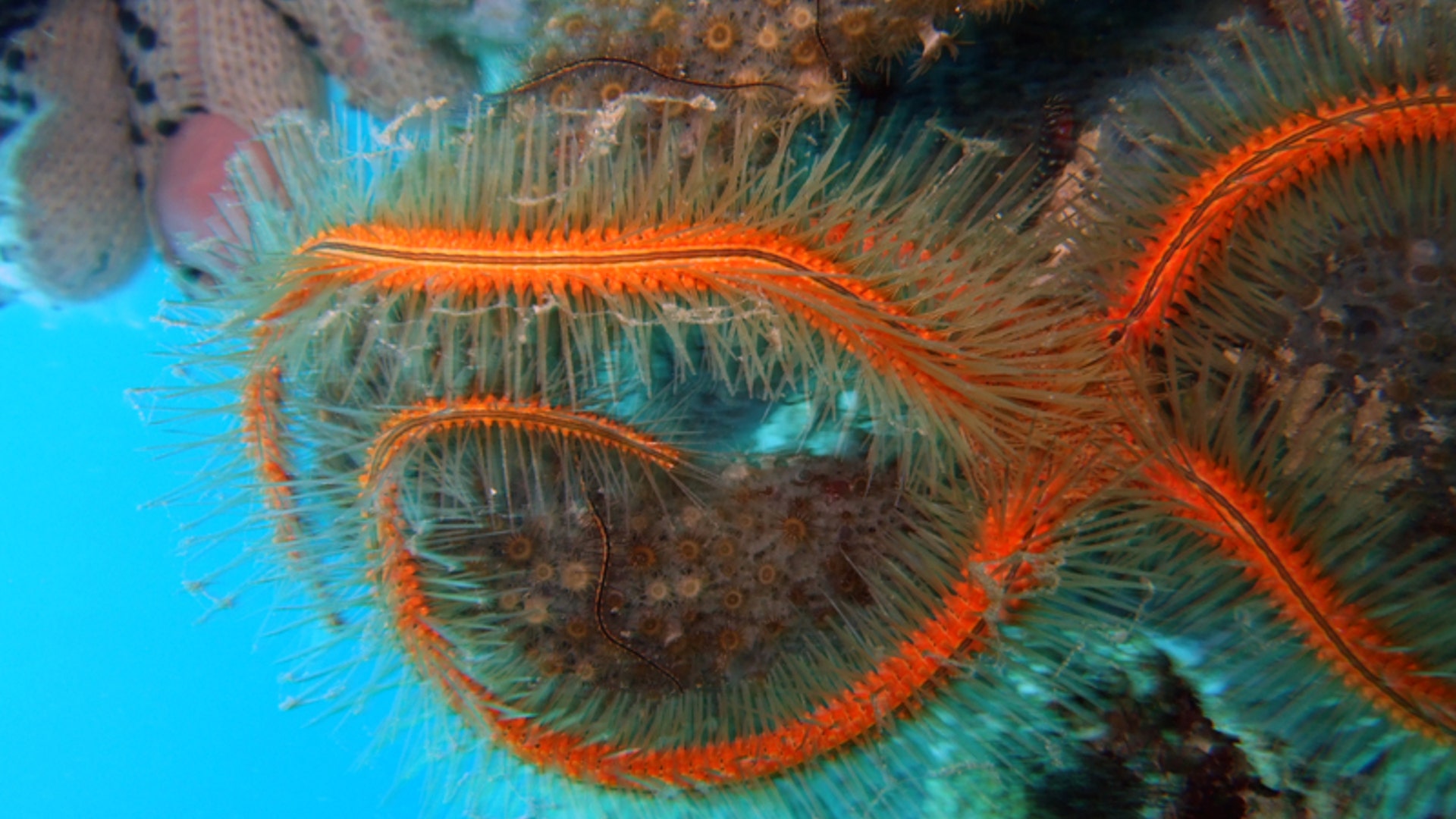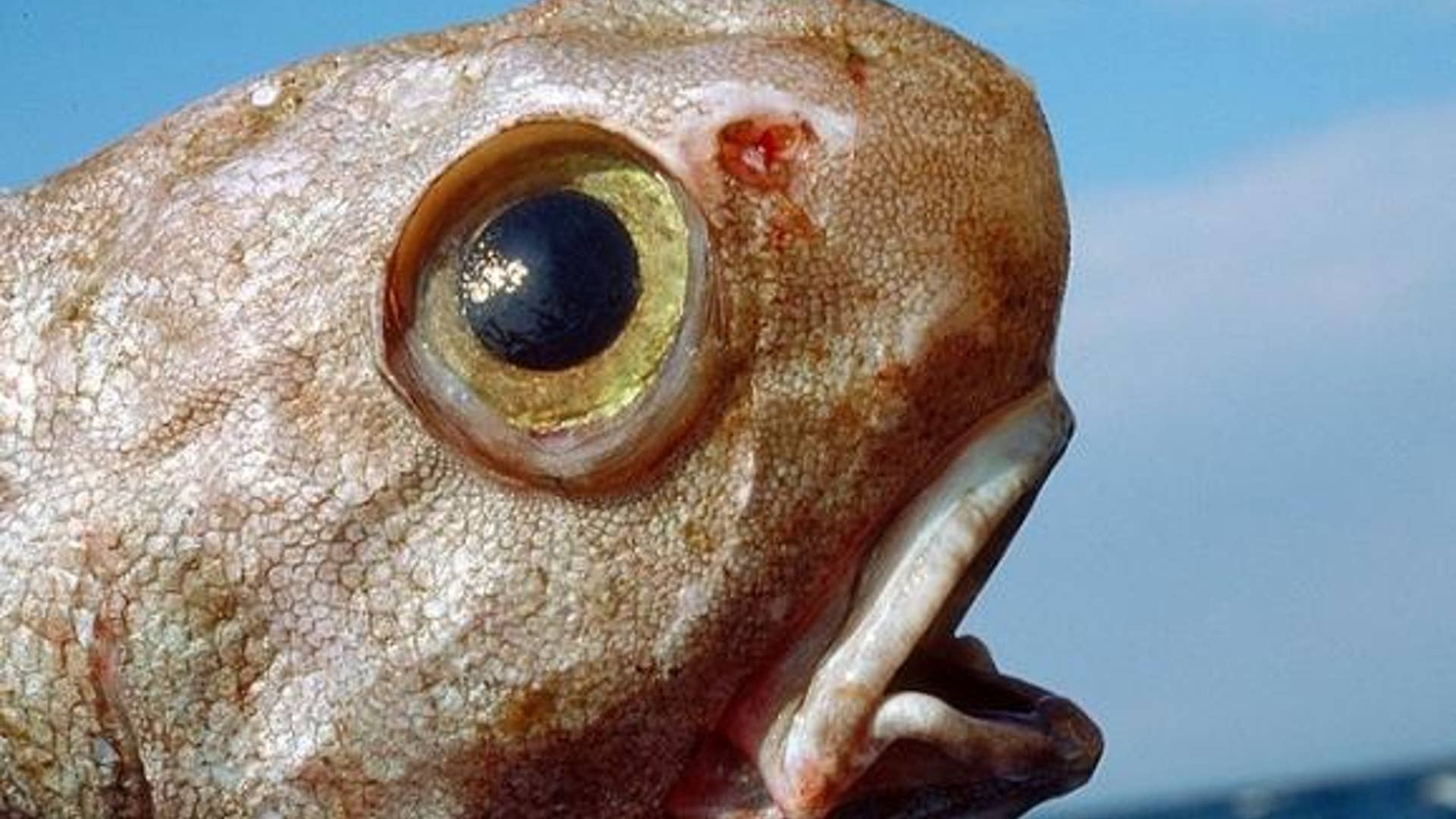Move Back
ADVERTISEMENT
Skip- Published54 Images
Deep-Sea Oddities From the Census of Marine Life
From the dragon fish (which has teeth on its tongue) to a glowing jellyfish to a worm that lives in and devours whale bones, the Census of Marine Life has turned up some bizarre creatures.
![Dragonfish]() Imagine living in the sea where it's permanently dark and cold, and food is hard to find. For many animals at depth it may be weeks to months between meals. And when they do find something to eat, they have to hang on to it. That's why so many deep-sea fishes have lots of big teeth. This dragonfish even has teeth on its tongue! They'd be terrifying animals -- if they were bigger than a banana.read moreDr. Julian Finn, Museum VictoriaShare
Imagine living in the sea where it's permanently dark and cold, and food is hard to find. For many animals at depth it may be weeks to months between meals. And when they do find something to eat, they have to hang on to it. That's why so many deep-sea fishes have lots of big teeth. This dragonfish even has teeth on its tongue! They'd be terrifying animals -- if they were bigger than a banana.read moreDr. Julian Finn, Museum VictoriaShare![Brittle_Stars]()
![Leptocheliidae]() Male Leptocheliidae are characterized by chelipeds, legs that in some cases significantly exceeding the body length. While normally held folded, they are extended fully forward during swimming. The extremely slender legs found in this group are unlikely to be capable of any feeding or locomotory function, however.read moreMagda Blazewicz-Paszkowycz, University of LodzShare
Male Leptocheliidae are characterized by chelipeds, legs that in some cases significantly exceeding the body length. While normally held folded, they are extended fully forward during swimming. The extremely slender legs found in this group are unlikely to be capable of any feeding or locomotory function, however.read moreMagda Blazewicz-Paszkowycz, University of LodzShare![Sea_Cucumber]()
![Brittle_Star]()
![Deep_Sea_Jellyfish]()
![Zombie_Worm]()
![Paper Bubble]()
![A_Solitary_Hydroid]()
![Deep-Water Octopus]()
![Creature, Featured]()
![Venus_Flytrap]()
![Spider_Conch]()
![Deep-Sea Anglerfish]()
![Deep-Sea Red Jellyfish]()
![Amphipod_Crustacean]()
![Deep-Sea Jellyfish]()
![Baby Octopus?]() Most cephalopods (like octopus and squid) go through a paralarval stage that can look very different from the adult, although both share arms with suckers and large eyes for visual hunting. Paralarvae are generally semi-transparent, but have some photophores that allow them to change appearance very rapidly.read moreCheryl Clarke-Hopcroft/UAF/CMarZShare
Most cephalopods (like octopus and squid) go through a paralarval stage that can look very different from the adult, although both share arms with suckers and large eyes for visual hunting. Paralarvae are generally semi-transparent, but have some photophores that allow them to change appearance very rapidly.read moreCheryl Clarke-Hopcroft/UAF/CMarZShare![Young_Hermit_Crab]() The soft curled tail of this decapod larva indicates it is turning into a young hermit crab. Already almost half a centimeter, it does not have much time left in this unprotected form. As soon as this larva settles, it will be in need of a snail shell to protect its unarmored rear section.read moreCheryl Clarke-Hopcroft/UAF/CMarZShare
The soft curled tail of this decapod larva indicates it is turning into a young hermit crab. Already almost half a centimeter, it does not have much time left in this unprotected form. As soon as this larva settles, it will be in need of a snail shell to protect its unarmored rear section.read moreCheryl Clarke-Hopcroft/UAF/CMarZShare![Angler_Fish]()
![Smiling_Tube_Anemone]() An earlier stage of the larval tube anemone, this specimen looks as if it has a smiling face inside. The common types of sea anemones spend little, if any, time in the plankton, as compared to tube anemones, which spend much longer and appear to feed while there.read moreCheryl Clarke-Hopcroft/UAF/CMarZShare
An earlier stage of the larval tube anemone, this specimen looks as if it has a smiling face inside. The common types of sea anemones spend little, if any, time in the plankton, as compared to tube anemones, which spend much longer and appear to feed while there.read moreCheryl Clarke-Hopcroft/UAF/CMarZShare![Larval_Spider_Crab]() The larval spider crab uses the numerous spines on its body to deter predators, but more importantly to increase its drag in the water to keep it from sinking, much like a parachute does. Like other larval phases, it is important both as a dispersal phase, and to take advantage of the abundant food in the plankton. This fellow is several millimeters in size.read moreCheryl Clarke-Hopcroft/UAF/CMarzShare
The larval spider crab uses the numerous spines on its body to deter predators, but more importantly to increase its drag in the water to keep it from sinking, much like a parachute does. Like other larval phases, it is important both as a dispersal phase, and to take advantage of the abundant food in the plankton. This fellow is several millimeters in size.read moreCheryl Clarke-Hopcroft/UAF/CMarzShare!['Girdle-Wearing' Burrowers]() Scientists last year described this new species of burrower, Culexiregiloricus trichiscalida, found 2.6 miles down in the Atlantic's Guinea Basin south of Cote d'Ivoire, Africa. Loriciferans, affectionately dubbed "girdle wearers" due to hind shells resembling a corset, are among the smallest known multi-cellular marine animals. This is a juvenile specimen with a body about 1/100th of an inch – roughly the width of three human hairs.read moreGunnar Gad, Marco Büntzow, Deutsches Zentrum für Marine Biodiversitätsforschung / German Centre for Marine Biodiversity Research, Senckenberg Research Institute, Germany / Census of Marine LifeShare
Scientists last year described this new species of burrower, Culexiregiloricus trichiscalida, found 2.6 miles down in the Atlantic's Guinea Basin south of Cote d'Ivoire, Africa. Loriciferans, affectionately dubbed "girdle wearers" due to hind shells resembling a corset, are among the smallest known multi-cellular marine animals. This is a juvenile specimen with a body about 1/100th of an inch – roughly the width of three human hairs.read moreGunnar Gad, Marco Büntzow, Deutsches Zentrum für Marine Biodiversitätsforschung / German Centre for Marine Biodiversity Research, Senckenberg Research Institute, Germany / Census of Marine LifeShare![Medusae_larvae]()
![Zoea__a_Young_Crab]()
![Deep Sea 'Dumbo']() From pole to pole, surface to frigid depths, researchers have discovered thousands of new ocean creatures in a decade-long effort now nearing completion, called the Census of Marine Life. And there may still be several times more strange creatures to be found. Grimpoteuthis looks like a primitive "dumbo" fish; the creature moves by flapping its ear-like fins. Researchers with the project have found about 5,600 new species on top of the 230,000 known. They hope to add several thousand more by October 2010, when the census will be doneread moreDavid ShaleShare
From pole to pole, surface to frigid depths, researchers have discovered thousands of new ocean creatures in a decade-long effort now nearing completion, called the Census of Marine Life. And there may still be several times more strange creatures to be found. Grimpoteuthis looks like a primitive "dumbo" fish; the creature moves by flapping its ear-like fins. Researchers with the project have found about 5,600 new species on top of the 230,000 known. They hope to add several thousand more by October 2010, when the census will be doneread moreDavid ShaleShare![Yeti_Crab]()
![File_Clam]()
![Fan_Worms]()
![Epimera, a New Crustacean]()
![Colonial_Salp_Jellyfish]()
![Antarctic_Sea_Urchin]()
![White Topped Coral Crab]()
![Deep Sea Cucumber]() At 2,750 meters deep in the Northern Gulf of Mexico, scientists found this odd, transparent sea cucumber, Enypiastes. The creature creeps forward on its many tentacles at about 2 centimeters per minute while sweeping detritus-rich sediment into its mouth.read moreLarry Madin, Woods Hole Oceanographic InstitutionShare
At 2,750 meters deep in the Northern Gulf of Mexico, scientists found this odd, transparent sea cucumber, Enypiastes. The creature creeps forward on its many tentacles at about 2 centimeters per minute while sweeping detritus-rich sediment into its mouth.read moreLarry Madin, Woods Hole Oceanographic InstitutionShare![Deep Sea Neocyema]()
![Deep Sea 'Dumbo']()
![Deep Sea Rat-Tail]()
![Deep Sea Copepod]()
![Blind Lobster]()
![Marine Spider]()
![Crassota]()
![Giant Bacteria]()
![Ghost Shrimp]()
![Polychaetes]()
![Cliona Limacina]()
![Jeweled Anemone Crab]()
![The Black Swallower]()
![Antarctic Sea Anemone]()
![Roundnose Grenadier]()
![Nudibranch]()
![Jellyfish]()
![Comb Jellyfish]()
![Antarctic Ice Fish]()
![Cuttlefish]()
- Published54 Images
Deep-Sea Oddities From the Census of Marine Life
From the dragon fish (which has teeth on its tongue) to a glowing jellyfish to a worm that lives in and devours whale bones, the Census of Marine Life has turned up some bizarre creatures.
Move Forward
- Deep-Sea Oddities From the Census of Marine Life






















































Thumbnail View
Image 0 of 54





















































